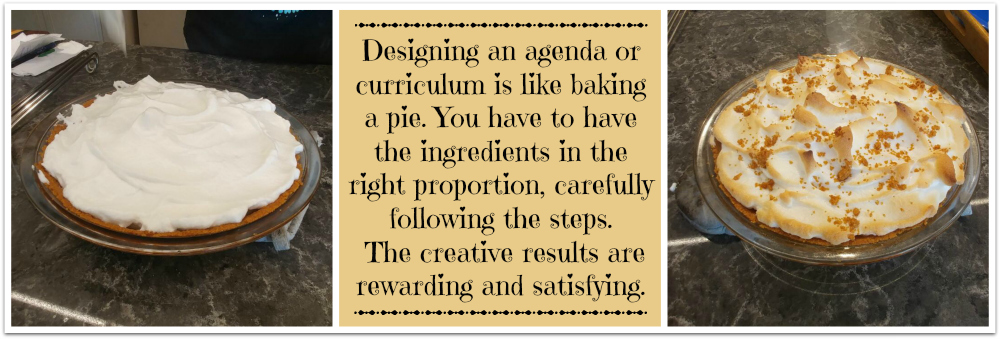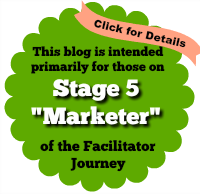Four Steps to Elegant Meeting Design

Recently I have been thinking a lot about designing. For months, I’ve been designing a three-part series for people who want to learn the essence of elegant meeting facilitation. There is nothing more satisfying to me than designing an agenda, or a curriculum. It is a creative and logical process that uses every once (gram!) of my thinking power. In fact, I feel powerful and humbled during the design process. It is even more satisfying to me to invite others into the process as my thinking power is more than doubled. Have you felt any of these things yourself? In this blog, I am going to talk briefly about how I went about designing the Meetings That Rock curriculum. And then show you how I apply those steps (which also serve as principles of design) to designing meetings.
When I first designed the Meetings that Rock series in 2014, it was complex and included almost every process I had ever used and found helpful. I distilled into six parts that I thought covered 90% of the competencies required for certification as a professional facilitator.

This year, I have gone back to that original Meetings That Rock curriculum of 2014. (Note I had wanted to call it “Meetings That Don’t Suck” but knew that was not appropriate – the term “Rock” in English is slang for “are really good”!) Here is what went into the design:
- I decided to vastly simplify the original curriculum for people who do not facilitate for a living. They do however, lead enough meetings to need some tangible guidance about how to do this more effectively. I simplified the curriculum to four key themes that occur in every meeting.
- I thought about how to explain a process to someone who may never have seen it done before. I thought about the things good facilitators do that require no preparation, yet were amazingly effective.
- I thought about English not being your mother language. I called in ten generous global testers (four countries, two continents, all generations) to tell me what worked for them in their cultures and generations. That course became “Meetings that Rock Light”. A course where anyone could absorb the basics in an hour (if they were in a rush) and then run meetings that were vastly more effective and empowering than the status quo meetings of their current organization.
- I thought about all the not for profit, schools, small businesses who have no money to train new leaders and made it affordable. I still consider it Prototype III. I have no doubt once I get more user feedback, I will create a refined version.
Here is the logo for that course:

Four Principles Or Steps
Here are my own design steps I use consistently to design longer 1/2 day to multi-day meetings or facilitated workshops. I have been influenced by many models – the ToP ORID model, the Stanford School of Design, my colleagues and mentors, creativity principles, my own art and meditation practices, etc. The steps/principles work equally well for those of you who design training curricula.
1. Know the Why and Who
Find out as much about the group as makes sense. Ask them great questions. See resources section below for earlier blogs on asking the client group great questions. Try giving your agenda as a whole or its key parts a name that holds its essence and that your intended audience will embrace. By “embrace” I mean you can imagine them saying, “This agenda is really going to have the impact we need”. I like to do this naming step early to keep the design essence in the front of my mind as I work through the next steps.

2. Then Diverge
By this I mean, cast wide and far for the best ideas. Don’t limit yourself to the tried and true ideas, processes or content you always use. Take risks. Combine ideas if it will strengthen the process. Keep asking: What processes will honor the Why and Who? I sometimes use mind mapping for this divergent process or put every different idea on a small post it and lay them out in front of me into like themes.

3. Next Converge
Trim it down to the absolute essentials. If nothing else is accomplished, what will that be? Remember my story about creating the Meetings That Rock Light and Essentials curricula. EVERYTHING but the key things can be abandoned. Focus all your attention here. Prioritize your essentials to no more than three things. Then prioritize those three things. Work on the top priority piece first. It is your focal point. Then everything else that comes before it helps warm the group up to this key piece, and everything that comes after it helps cement it, produce it, and builds ownership of it.

4. Step Back and Refine
Then go back and think about the big picture again. Redo a mind map of your current agenda. Look at the overall flow. Does each piece segue neatly into the next one? Do you allow enough time to connect people to the design, to each other and to the key topic they must tackle? Have you left ample time for the top priority topic? Will they accomplish what was needed and have great closure? Remove any frills if they are not essential.

Bonus: Don’t forget dark chocolate helps enormously with designing!

Resources
Blog: I Don’t Know What to Ask My Client! – Tips for a Successful Interview





Great framework Barbara, thank you – and nicely aligned with my own so called universal principle 🙂 https://martingilbraith.com/2014/02/25/four-steps-to-a-universal-principle-of-facilitation-and-learning/